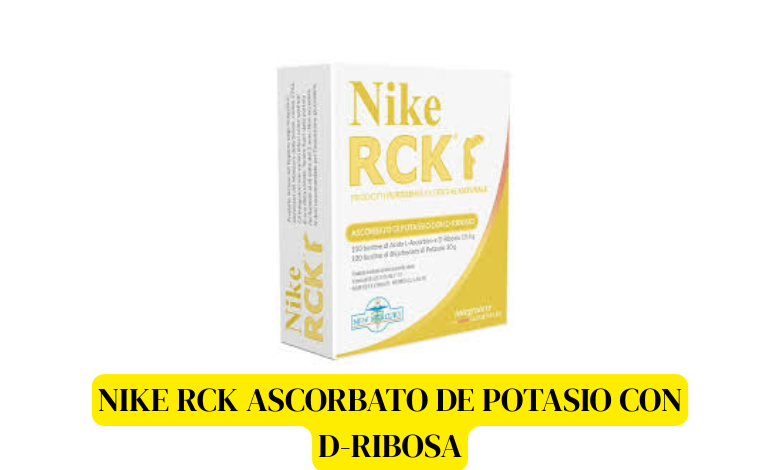Nike rck ascorbato de potasio con d-ribosa

Supplements that combine vitamins, minerals, and metabolic sugars always catch my attention, especially when they propose cellular-level benefits. NIKE RCK Potassium Ascorbate with D-Ribose (often shortened as PAR) is one such formulation that brings together a salt of vitamin C (ascorbate), potassium, and D-ribose. Proponents claim it has strong antioxidant action, supports energy production, and even may play a role in cancer adjunct therapy.
When I first heard about it, I was both intrigued and skeptical. How much of this is science, how much is hype, and is it safe? So I dug into the literature, analyzed case reports, and talked to people experienced with it. In this article I’ll walk you through:
-
What the compound is (chemistry, composition)
-
How the ingredients work (mechanism)
-
What benefits are claimed
-
What existing scientific evidence supports or disputes those claims
-
Safety, risks, dosages
-
How people typically use it
-
My perspective and advice
-
FAQs and conclusions
My aim: to present a fair, understandable, and evidence-grounded discussion so you (or anyone) can decide more wisely if something like this is worth exploring (under medical supervision). I’m not endorsing it, but I’ll give you what I found.
2. What is Potassium Ascorbate with D-Ribose (PAR / NIKE RCK)
Potassium Ascorbate: definition
Potassium ascorbate is the potassium salt form of ascorbic acid (vitamin C). Chemically, where ascorbic acid has an acidic hydrogen, it is substituted by potassium. The formula is often written as KC_6H_7O_6. Ascorbate (the deprotonated form) is a powerful antioxidant, one reason vitamin C is prized.
In nutrition and supplement fields, ascorbates (sodium, potassium, calcium ascorbate) are often used as buffered forms of vitamin C — less acidic, gentler on the stomach. But potassium ascorbate is less common than sodium or calcium ascorbate.
Beyond simple vitamin C supplementation, some propose that the potassium moiety adds a cellular benefit: potassium is a vital intracellular ion involved in nerve conduction, muscle contraction, and maintaining the cell’s resting membrane potential.
Also, in food science, potassium ascorbate has been used as an antioxidant additive (E303) in some countries. But regulatory status varies across regions.
D-Ribose: definition and role
D-Ribose (often just “ribose”) is a five-carbon sugar that is part of the backbone of RNA, DNA, and is critical in energy metabolism (ATP, ADP, AMP). In our bodies, ribose is produced via the pentose phosphate pathway and used in synthesizing nucleotides and supplying the sugar backbone for nucleic acids.
Because ribose is intimately tied to energy molecules (ATP), it is theorized that providing supplemental ribose may help the body regenerate or maintain energy in tissues with high demand.
Some people take ribose as an energy-enhancing supplement, especially in conditions where energy metabolism is compromised (e.g. chronic fatigue syndrome, heart disease).
Read Also: Complete Guide to the D-Troxx Wheel Pack for BeamNG: Features, Installation, Review, and FAQ
What is “NIKE RCK” version?
“NIKE RCK Ascorbato de Potasio con D-Ribosa” is a commercial formulation of PAR. According to its product listing, the composition per dose is:
-
One sachet containing 150 mg of L-ascorbic acid + 3 mg of D-ribose
-
One sachet containing 300 mg of potassium bicarbonate
The instructions specify dissolving both in about 20 mL (cc) of water and taking once per day, preferably in the morning on an empty stomach (unless medically specified otherwise).
The marketing claims strong antioxidant action due to the potassium ascorbate, and that D-ribose helps “accelerate” potassium transport into the cell (i.e. facilitating intracellular uptake).
So, unlike just taking vitamin C or potassium separately, the idea is that combining them with ribose enhances cellular uptake and effectiveness.
3. Mechanism: How They Work Together
To understand why people are interested in PAR, let’s break down how each component functions, and what synergy is proposed.
Antioxidant properties of ascorbate
Ascorbate is well known to neutralize reactive oxygen species (ROS) — free radicals — which damage lipids, proteins, DNA, etc. Thus, vitamin C is a frontline antioxidant. When converted to a less reactive radical, it can be recycled back to active form in some cellular systems (with help from other antioxidants).
One challenge is delivering antioxidant capacity deep inside cells where it’s needed most. Having the ascorbate in salt form (potassium ascorbate) may help with pH balance and reduce acidity, but its antioxidant ability is fundamentally the same or similar to regular ascorbate.
Potassium’s role in cells
Potassium is the primary intracellular cation (positive ion). Cells maintain high internal potassium and low sodium, which is critical for:
-
Resting membrane potentials (nerve/muscle excitability)
-
Enzyme activity (many enzymes need K⁺ for optimal function)
-
Osmotic balance, volume regulation
It’s theorized that by supplying potassium in the ascorbate salt, one could help maintain or restore intracellular potassium balance — especially in cells under stress or degeneration.
However, merely providing potassium outside might not efficiently raise intracellular potassium unless transport systems (membrane pumps, channels) are favorably oriented.
D-Ribose and energy metabolism (ATP production)
Ribose plays a central role in the structure of ATP (adenosine triphosphate). The pathway is that ribose contributes to the backbone, enabling ATP synthesis and recovery.
When tissues are under heavy demand or stress (e.g. after ischemia, injury, or disease), ATP depletion can occur. The idea is that supplemental ribose may help in faster replenishment of ATP pools, supporting recovery. Some studies showed ribose improves ATP recovery in muscle after intense exertion.
Hypothesized synergy / cellular uptake
The unique claim of PAR is that the presence of D-ribose “catalyzes” or accelerates potassium’s entry into the cytoplasm (interior of the cell). The notion is that ribose helps the cell’s metabolic machinery accept and use potassium more effectively. Some anecdotal and nonrandomized sources make that claim.
In this view, potassium ascorbate + ribose is more than sum of parts — you get antioxidant benefit plus improved potassium uptake and metabolic support.
In practical terms, this mechanism is plausible in theory but requires further mechanistic proof (e.g. direct measurement of intracellular K⁺ uptake with vs without ribose). Some in vitro lab studies do examine effects on cell proliferation or apoptosis, but direct transport studies are less common.
4. Purported Benefits & Uses
What do proponents claim? And which seem more credible given evidence? Let’s go through main claims.
Antioxidant / cellular protection
One of the clearest rationales is that PAR offers stronger antioxidant protection than simple vitamin C forms, especially under stress or degenerative conditions. Because ascorbate is combined with potassium and ribose, proponents argue it may reach into cells more effectively, mitigating oxidative damage.
This is consistent with the known biology: oxidative stress contributes to aging, chronic disease, and cell damage. If PAR can deliver antioxidant effect intracellularly, that may be beneficial in pathological contexts.
Energy, fatigue, recovery
Because ribose supports ATP synthesis, PAR might help in conditions of energy deficiency (e.g. chronic fatigue, post-illness recovery). The idea is that PAR helps both by protecting mitochondria (via antioxidant action) and by supporting energy substrate (ribose) supply.
Some individuals using it report increased vitality, better recovery after stress, or lower fatigue. These are anecdotal; systematic clinical trials are limited.
Use in oxidative stress conditions
Diseases or states with elevated oxidative stress — e.g. chronic inflammation, aging, metabolic syndrome, neurological stress — are natural targets for antioxidant strategies. PAR is sometimes proposed as a supportive adjuvant in such conditions.
Possible anti-cancer / adjuvant role
This is where much of the interest (and controversy) lies. Some laboratory studies have examined PAR’s effects in cancer cell lines, especially melanoma.
-
In the 2017 paper “Potassium Ascorbate with Ribose: Promising Therapeutic Approach for Melanoma Treatment”, authors observed that PAR reduced proliferation and altered cell communication in melanoma cells in 2D and 3D models.
-
Another study on “Antioxidant Effects of Potassium Ascorbate with Ribose in Costello” reported skin and hair improvements in certain patients.
-
In a distinct use case, PAR was introduced as an antioxidant agent in Prader-Willi syndrome patients over a long period, showing reduction in oxidative stress biomarkers.
These results are interesting but preliminary. They may support PAR as a complementary agent (adjuvant) rather than a primary therapy.
Other possible uses (general wellness / aging)
Because oxidative damage is implicated in aging, mitochondrial decline, and chronic disease risk, PAR is sometimes pitched in preventive or anti-aging contexts. Whether this is justified is uncertain; evidence is thin.
5. Review of Scientific Evidence
To avoid overclaiming, let’s critically examine what studies exist, what they show, and where gaps lie.
In vitro / lab (cell culture) studies
The melanoma research is one of the more cited areas. In those experiments:
-
Human melanoma cell line A375 treated with PAR (100 μM to 2 mM) showed reduced cell proliferation, increased apoptosis/LDH release, and disruption to spheroid formation in 3D models.
-
Connexin 43 (a gap-junction protein) expression was affected, suggesting changes in intercellular communication.
-
In spheroid (3D) models, PAR impaired compactness of clusters, indicating interference in tumor cell aggregation.
These in vitro results suggest PAR has cell-level effects against melanoma models, under controlled conditions. But:
-
These are cell lines, not whole organisms
-
Dosages in those cultures may not be achievable or safe in vivo
-
Cancer is extremely complex; what works in petri dish often fails in living organisms
So while promising, these data are far from proof.
Animal / human / case studies
There are fewer human studies. Some notable ones:
-
In a case series of patients using PAR (with other treatments), the authors report skin, hair, and psychomotor improvements.
-
In Prader-Willi syndrome (a rare genetic disorder), PAR was used together with growth hormone therapy, and over 4 years they observed normalization of oxidative stress biomarkers, weight loss, and improved growth parameters.
-
However, these are case or observational reports, not randomized controlled trials. Also, these patients often had multiple interventions, so isolating PAR’s effect is difficult.
In cancer therapy contexts, mainstream oncology has not (as of now) adopted PAR as standard. The evidence base is largely preclinical.
Strengths, weaknesses, gaps
Strengths / supportive aspects:
-
The biological rationale (antioxidant + energy substrate + potassium) is internally consistent and plausible
-
Some in vitro results show measurable effects on cancer cell lines
-
Few reports of overt toxicity in the doses used
Weaknesses / gaps:
-
Lack of large, well-designed clinical trials
-
Unclear pharmacokinetics: how much of the compound reaches target cells?
-
Dosing translation from culture to human is uncertain
-
Possible side effects in humans need more systematic study
-
Interactions with other therapies (particularly in disease states) are not well characterized
Conclusion on evidence: PAR is an interesting candidate worth further study. It may serve as an adjuvant or supportive therapy in specific contexts, but it should not be considered a standalone cure. Any use needs careful medical supervision.
6. Dosage, Safety & Risks
Because PAR is still not mainstream, any dosage and safety guidance must be cautious and based on limited data.
Typical formulation / dosage (NIKE RCK)
As noted earlier:
-
The NIKE RCK product uses 150 mg L-ascorbic acid + 3 mg D-ribose in one sachet
-
And 300 mg potassium bicarbonate in another sachet
-
Taken dissolved together in ~20 mL water, once daily, ideally morning on empty stomach (unless doctor advises otherwise)
This is a relatively modest dose of ribose and vitamin C, and a moderate potassium input (300 mg from bicarbonate). For context, many ribose supplement trials use grams (1,000 mg or more).
This suggests that the NIKE RCK formulation is conservative, likely intended for safety and moderate support rather than high-dose therapy.
Known side effects, risks, and unknowns
From literature and general knowledge:
-
Gastrointestinal discomfort: any supplement can cause nausea, diarrhea, cramping—ribose in higher doses is known to sometimes induce GI side effects.
-
Blood sugar lowering / hypoglycemia: ribose may lower blood sugar in some individuals. This raises concern for people with diabetes or on glucose-lowering drugs.
-
Electrolyte imbalance / hyperkalemia: adding potassium is risky if kidney function is impaired, or if potassium intake is high from other sources. High serum potassium (hyperkalemia) can be dangerous.
-
Unknown long-term safety: systematic long-term human studies are lacking.
-
Interactions: possible interactions with medications (diuretics, ACE inhibitors, potassium-sparing diuretics, insulin, etc.)
-
Renal / kidney strain: for those with kidney disease, any extra load of potassium or other ions must be carefully managed
Given these risks, monitoring (electrolytes, kidney function, glucose) is prudent when using such supplements.
Precautions and monitoring
-
Always use under medical supervision (especially if you have chronic disease, kidney issues, heart conditions)
-
Start with lowest effective dose, observe tolerance
-
Monitor blood potassium, kidney function (creatinine, eGFR), and electrolytes regularly
-
Be cautious if also on potassium supplements, salt substitutes, or medications that raise K⁺
-
If you experience symptoms of hyperkalemia (e.g. muscle weakness, palpitations) or hypoglycemia, stop use and consult physician
7. How to Use It in Practice
If one chooses to try PAR (e.g. NIKE RCK), here are practical considerations and tips.
Mixing, timing, and frequency
-
Dissolve both sachets (ascorbic acid + ribose, and potassium bicarbonate) in ~20 mL of water (nonmetal utensils advised)
-
Use non-metal spoons or gentle swirling to mix (to reduce oxidation)
-
Best taken in the morning on an empty stomach, unless a doctor recommends otherwise
-
Taking it before meals may ensure better absorption and minimal interference
-
Usually once per day; splitting doses is not commonly recommended in the existing protocol
If higher therapeutic doses are considered (in experimental protocols), more frequent dosing might be considered—but that increases risk and requires monitoring.
Storage and stability
-
Ascorbic acid and bicarbonate salts are both sensitive to moisture and light
-
Products should be kept in dry, airtight, light-protected containers (e.g. aluminum foil packs, sealed sachets)
-
Avoid humidity; once opened, exposure to air can degrade potency
-
In some sources, preparation of ascorbate + bicarbonate is discouraged in capsule form because moisture ingress degrades purity.
Choosing a quality product
If buying a PAR supplement (like NIKE RCK):
-
Verify purity (pharmaceutical grade, minimal impurities)
-
Check labeling: amounts of ascorbate, ribose, potassium
-
Prefer independently tested / third-party lab verification
-
Ensure packaging protects against moisture and light
-
Check that other ingredients (fillers, excipients) are minimal
If possible, inquire for a certificate of analysis (COA) from manufacturer.
Tips for beginners / low risk approach
-
Start with a “test dose” (half or quarter) and assess tolerance (GI, general feeling)
-
Don’t combine with other potassium supplements unless required and supervised
-
Use for limited periods initially, reassess after weeks or months
-
Keep a journal: note energy, side effects, labs (potassium, kidney, glucose)
8. My Personal Thoughts & Use Cases
Here’s what I think based on all I saw and what I’d do if I were considering PAR:
-
The biological rationale is compelling. Combining antioxidant (ascorbate), an essential ion (potassium), and metabolic sugar (ribose) has theoretical synergy.
-
The in vitro data in melanoma models is interesting but not definitive. I would not expect PAR to “cure” cancer, but it may offer mild adjuvant support in certain controlled conditions.
-
For general wellness or anti-aging, I’m cautious. Many antioxidant supplements have shown limited benefit in large trials, possibly because redox balance is delicate and over-supplementation may blunt beneficial stress responses.
-
In people with fatigue, mitochondrial dysfunction, or chronic disease where energy metabolism is impaired, PAR might be more plausible to test (under supervision). The ribose component is particularly relevant there.
-
Safety is paramount. Because of potassium content and possible glucose effects, I would only use it with regular labs, starting low.
If I were to try it, I’d do:
-
Basic baseline labs (electrolytes, kidney, glucose)
-
Start at half dose for a week, note tolerance
-
If tolerated, move to full dose
-
Re-assess labs after 4–6 weeks
-
Use it perhaps in cycles (on for weeks, off for breaks) rather than indefinitely
I’d be especially cautious if combining with medications (e.g. diuretics, ACE inhibitors, insulin). For patients with cancer, I’d only use in consultation with oncologists and not as a substitute for evidence-based therapies.
9. Common Questions & Myths (FAQ)
Q: Is PAR just another form of vitamin C?
A: Not exactly. While it contains vitamin C (ascorbate), PAR is distinct in that it also includes potassium and ribose, aiming for deeper cellular effects beyond simple antioxidant supply.
Q: Can PAR cure cancer?
A: No credible human clinical evidence supports “curing cancer.” Some lab studies show effects on cancer cells, but those are preliminary. PAR may only serve, at best, as a supporting adjuvant, and only under strict supervision.
Q: Can healthy people benefit from PAR?
A: Possibly modest benefit, but I’d be skeptical. In healthy individuals with balanced metabolism, adding more antioxidant/metabolic substrate may offer marginal gain and risk perturbing redox homeostasis.
Q: Is long-term use safe?
A: Long-term safety remains uncertain. Because we lack long-term controlled studies, it’s better to use for defined periods and monitor labs rather than continuous use indefinitely, especially in higher doses.
Q: Are there alternatives?
A: Other buffered vitamin C forms (calcium ascorbate, sodium ascorbate), potassium supplements, or ribose alone are alternatives. But they don’t have the “combo” design. Also, standard antioxidant strategies (dietary, lifestyle) remain fundamental.
10. Conclusion
The combination of potassium ascorbate and D-ribose (as in NIKE RCK / PAR) is an intriguing supplement strategy. It blends antioxidant function, intracellular ion support, and metabolic sugar in a single formula. From lab studies, some effects in cell models (especially melanoma) are promising. Some case reports in humans suggest possible beneficial effects (reduced oxidative stress, improved tissue markers).
However, the evidence is still weak for strong therapeutic claims. The real-world challenge is ensuring delivery to target cells, maintaining safety (especially with potassium and glucose effects), and proving benefits beyond placebo or standard care.
If someone is curious to try it, they should do so cautiously: start low, monitor labs, don’t expect miracles, and always keep medical oversight. For now, PAR is best viewed as an experimental adjunct, not a mainstream therapy.



